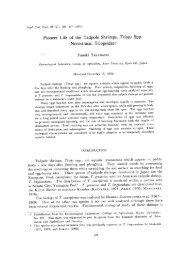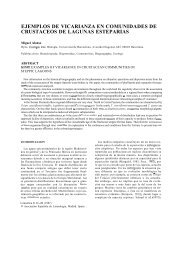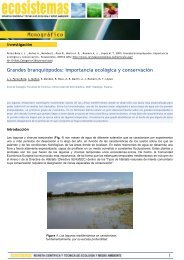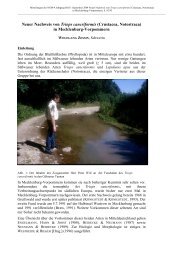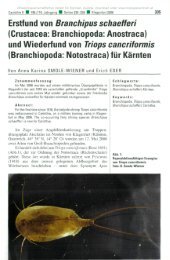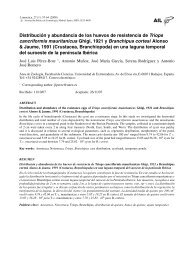Reproductive isolation and genetic differentiation in North American ...
Reproductive isolation and genetic differentiation in North American ...
Reproductive isolation and genetic differentiation in North American ...
Create successful ePaper yourself
Turn your PDF publications into a flip-book with our unique Google optimized e-Paper software.
130<br />
Figure 2. Genetic relatedness of Triops populations based on electrophoretic data. A. Phenogram generated by UPGMA cluster<strong>in</strong>g of Nei’s<br />
unbiased distances. B. Dendogram generated by maximum likelihood neighbor jo<strong>in</strong><strong>in</strong>g of populations.<br />
exhibit only female-biased or unisexual states (Table1),<br />
<strong>and</strong> males rarely exceed 16% of the population.<br />
Previous laboratory studies on several populations<br />
of Triops newberryi have <strong>in</strong>dicated that females from<br />
both female-biased <strong>and</strong> from unisexual populations,<br />
when reared entirely <strong>in</strong> <strong>isolation</strong> from hatch<strong>in</strong>g, nevertheless<br />
produce viable cysts (Sassaman, 1991). Furthermore,<br />
the pattern of appearance of males <strong>in</strong> clutches<br />
produced dur<strong>in</strong>g unisexual reproduction <strong>in</strong> this<br />
species (Sassaman, 1991), by analogy with comparable<br />
patterns <strong>in</strong> the conchostracan Eulimnadia texana<br />
(Sassaman & Weeks, 1993), <strong>in</strong>dicates that reproduction<br />
is by self<strong>in</strong>g hermaphroditism.<br />
Females from eastern populations of Triops longicaudatus<br />
(those with sex ratios near equality) do not<br />
produce viable cysts when reared <strong>in</strong> <strong>isolation</strong>.The cysts<br />
that are produced are irregular <strong>in</strong> size, shape, <strong>and</strong> color;<br />
they lack the normal extra-embryonic coat<strong>in</strong>gs; <strong>and</strong><br />
they do not hatch upon subsequent hydration. Limited<br />
experiments with females from the Ch<strong>in</strong>le Wash population<br />
(the only female-biased population of T. longicaudatus<br />
that we have studied), however, have yielded<br />
some viable cysts produced by females reared <strong>in</strong> <strong>isolation</strong>.<br />
Individualsfrom unisexual populations of T. longicaudatusproduce<br />
viable cysts when reared <strong>in</strong> <strong>isolation</strong><br />
<strong>and</strong> histological evidence (Longhurst, 1955b; Akita,<br />
1971; 1976) <strong>in</strong>dicates that they are self-compatible hermaphrodites.<br />
(For a review of the reproductive biology<br />
of notostracans, see Sassaman (1991).)<br />
We follow the term<strong>in</strong>ology of Sassaman (1995:Figure<br />
2) to denote the various populations of Triops <strong>in</strong><br />
terms of the reproductive characteristics of their life<br />
cycles. Thus, bisexual populations (those conta<strong>in</strong><strong>in</strong>g<br />
males) <strong>in</strong>clude both those with an obligately outcross<strong>in</strong>g<br />
mode of reproduction (gonochoric) <strong>and</strong> those with a<br />
mixed mat<strong>in</strong>g system <strong>in</strong>volv<strong>in</strong>g outcross<strong>in</strong>g <strong>and</strong> facultative<br />
self<strong>in</strong>g (<strong>and</strong>rodioecious). Unisexual populations<br />
of <strong>North</strong> <strong>American</strong> Triops all presumably reproduce<br />
entirely by self<strong>in</strong>g.<br />
Genetic correlates of reproductive biology<br />
On the basis of allozyme <strong>differentiation</strong> (Figure 2) <strong>and</strong><br />
reproductive characteristics (Table 1), there are five<br />
potentially dist<strong>in</strong>ct biological entities of <strong>North</strong> <strong>American</strong><br />
Triops: unisexual <strong>and</strong> <strong>and</strong>rodioecious populations<br />
of T. newberryi, <strong>and</strong> gonochoric, <strong>and</strong>rodioecious <strong>and</strong><br />
unisexual populations of T. longicaudatus. InT. newberryi,<br />
<strong>and</strong>rodioecious <strong>and</strong> unisexual populations are<br />
not sharply demarcated from each other; there is a cont<strong>in</strong>uous<br />
gradation of sex ratios from 16% males to an<br />
apparent absence of males (Table 1). Because of this<br />
gradation, no population can be proven to lack males<br />
completely; we can only estimate from our data the<br />
maximum frequencies <strong>in</strong> which they might occur <strong>in</strong>



